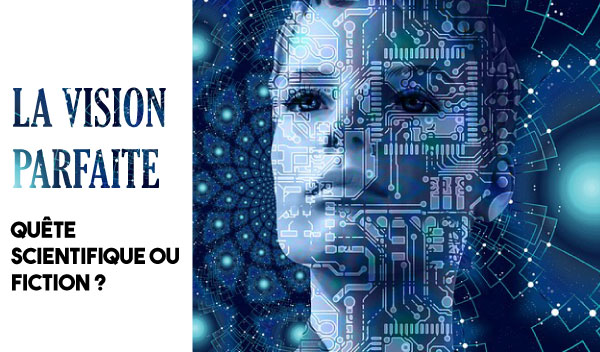The Perfect Vision: Scientific Quest or Fiction?

For centuries, the quest for perfect vision has fascinated humanity. But is this idea, fueled by science fiction stories and medical advances, truly within our reach? While technological advances continue to improve our ability to see more clearly, farther, or in low light, it is important to understand that human vision, like any biological function, has natural limits. This article explores these limits and the emerging technologies that could one day push these boundaries.
Perfect vision versus the biological limits of human vision
Our eye, while complex and efficient, has inherent constraints. Visual acuity, typically measured by tests such as Snellen's ("20/20" being considered the norm), depends on the retina's ability to distinguish fine detail. However, even with perfect acuity, there is a limit to the resolution that the human eye can perceive, dictated by the density of photoreceptors in the retina and the diffraction of light in the eye. Beyond a certain point, the finest details can no longer be distinguished.

The human field of vision is limited to approximately 180 degrees horizontally and 135 degrees vertically. This natural restriction not only affects our ability to perceive objects in the periphery, but also influences our perception of the environment as a whole. Our eye is also sensitive to a specific range of wavelengths of light, between approximately 400 nm (violet) and 700 nm (red). This means that we cannot see infrared or ultraviolet rays, while some animals , such as bees or snakes, can perceive these frequencies.
Over time, phenomena such as presbyopia, cataracts or age-related macular degeneration deteriorate the quality of vision. Even with preventive care and treatments, these natural processes are inevitable. All these limitations determine the "improvement points" that our vision would need to become perfect. But again, our perception of perfect vision can differ from one individual to another, making this concept of "perfect vision" subjective.
Pushing the Limits: Emerging Technologies
Although the biological limitations of the human eye are undeniable, emerging technologies aim to push these boundaries, with innovations in both the medical and optical engineering fields.
Advances in refractive surgery and intraocular lenses , which replace the damaged natural lens with artificial lenses, not only restore vision, but in some cases improve it beyond the human norm. Retinal implants, such as those developed for patients with retinitis pigmentosa, are paving the way for restoring vision in cases of partial blindness.

Augmented reality devices , such as AR glasses, are already capable of superimposing digital information onto our real-world surroundings. While these technologies do not directly alter biological vision, they do extend our ability to perceive and interact with our surroundings. Companies like Mojo Vision are also working on AR contact lenses, ushering in a new era where augmented vision becomes a true superpower.
Research is underway to create lenses that can adjust their shape in real time, based on the user's needs, eliminating the need for progressive lenses. Additionally, prototype bionic lenses aim to provide vision beyond the human norm, allowing for sharper vision in low-light environments or at great distances.
With the rise of techniques such as CRISPR (Clustered Regularly Interspaced Short Palindromic Repeats – a molecular tool that allows for precise gene corrections), gene editing could offer solutions to correct genetic disorders that affect vision , such as Leber congenital amaurosis or other forms of retinal degeneration. By directly modifying the genes responsible for vision, these treatments could not only cure, but also improve the visual capacity of individuals. Again, there is much scientific progress to be made .
Finally, research into brain-computer interfaces (BCIs) and artificial vision systems, such as those proposed by companies like Neuralink , could allow people with visual impairments to bypass the eye entirely and transmit visual information directly to the brain. This technology is still in its early stages, but it represents a fascinating possibility for pushing the limits of human vision.
The Myth of Perfect Vision: A “Post-Human” Vision?
As we have seen, the idea of perfect vision is based on a subjective notion, but also on other questions. To what extent, for example, can we optimize human vision without distorting its fundamental aspects? While vision correction aims to restore functional vision, technological augmentation could lead humanity into a new era of "post-human" vision, where visual capacities would exceed natural standards.
However, these technologies also raise ethical questions. If we are able to improve our vision beyond what nature allows, what will be the cost for society and for the individual? Who will have access to these technologies and under what conditions?

“Post-human” vision evokes the idea of a radical transformation of our visual capacities , surpassing the natural limits of the eye. With technologies such as bionic lenses or brain-computer interfaces, human vision could be augmented beyond the visible spectrum, allowing us to perceive wavelengths invisible to the naked eye, such as infrared or ultraviolet. These innovations could also offer ultra-precise vision, far surpassing traditional visual acuity.
By surpassing the biological limits of perception, will we redefine what it means to be human? Access to these technologies could also create new forms of inequality , between those able to benefit from these improvements and those who are excluded from them. Perfect vision, in this sense, could become a symbol of augmented humanity, at the crossroads of biology and technology.
The myth of perfect vision will probably remain out of reach for humans, at least in biological terms. However, thanks to technological advances, it is clear that the boundaries of vision are continually being pushed back. Bionic lenses, retinal implants, and brain-computer interfaces are transforming the way we think about vision, bringing humanity ever closer to an augmented version of reality. But these advances, while promising, also require deep reflection on their long-term impact on society and our own perception of what “perfect vision” is.


